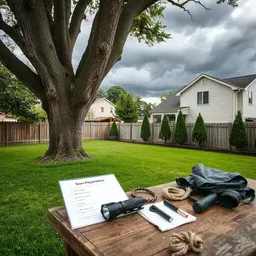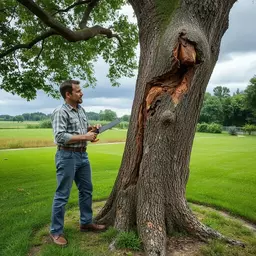Storm-Ready Landscaping Tips

Storms can be unpredictable and devastating, but a well-prepared landscape can significantly reduce potential damage. How prepared is your yard for the next storm? Understanding and implementing storm preparedness strategies can safeguard your property and provide peace of mind.
What You Will Learn
- Protection of Property: Proactive landscaping minimizes the risk of storm damage to your home and surroundings.
- Safety First: Prepared landscapes reduce hazards posed by falling branches and uprooted trees.
- Soil Health Matters: Understanding soil erosion and drainage can prevent long-term damage to your plants after storms.
- Immediate Recovery Actions: Quick damage assessment and targeted recovery strategies can revitalize your landscape post-storm.
- Effective Plant Care: Proper watering, pruning, and fertilization can help stressed plants recover efficiently.
- Soil Restoration Techniques: Adding organic matter and conducting soil tests can enhance soil health and resilience.
- Comprehensive Preparedness Checklists: Regular tree inspections and drainage evaluations are essential for storm readiness.
Essential Steps for Enhancing Landscape Resilience Against Storms
Proactive measures can significantly improve your landscape's ability to withstand storms. Below are key strategies that homeowners can implement. For more insights on safeguarding your property, consider these long-term tree risk management tips.
Tree Inspections
Regularly inspect trees for hazards such as broken branches or signs of decay. This helps prevent dangerous situations during storms.
Soil Erosion Prevention
Implement measures to prevent soil erosion, such as mulching and planting cover crops, to protect your landscape's integrity.
Effective Drainage
Ensure that your landscape has proper drainage systems to prevent standing water that can damage plants and soil.
Post-Storm Plant Care
After a storm, ensure adequate watering and proper pruning of affected plants to promote healthy recovery.
Understanding the Importance of Storm Preparedness in Landscaping
As a tree safety expert, I want to emphasize that storm preparedness in landscaping is crucial for protecting your property and ensuring its longevity. When the winds whip up and dark clouds roll in, having a resilient landscape can mean the difference between minimal damage and significant destruction. Homeowners often underestimate how prepared their yards are for storms, but being proactive can save time, money, and stress in the long run!
Why Storm Preparedness Matters for Your Landscape
Storms can wreak havoc on both small and large landscapes. Implementing storm preparedness strategies helps in several key ways:
- Protection of Property: Well-prepared landscapes minimize the risk of damage to your home and surroundings.
- Safety First: Reducing hazards from falling branches or uprooted trees protects your family, pets, and visitors.
- Preservation of Investment: A beautiful landscape enhances your property's value; keeping it safe from storms safeguards that investment.
At Safe Canopy Care, we believe that adopting proactive measures ensures that your landscape can withstand whatever nature throws its way. A little preparation goes a long way!
The Impact of Hurricanes and Tropical Storms on Landscaping
Hurricanes and tropical storms can cause devastating effects on your landscape. Understanding these impacts can guide your storm preparedness efforts:
- Tree Damage: High winds can uproot or break trees, leading to dangerous situations. Learning about hazardous tree removal best practices can be crucial here.
- Soil Erosion: Heavy rains can lead to soil loss, impacting the health of your plants.
- Flooding: Poor drainage in your landscape can result in standing water, damaging roots and creating unhealthy conditions for your plants.
By recognizing these potential issues, you can take steps to protect your landscape. My experience has shown me that planning ahead not only safeguards your property but also gives you peace of mind. So, never underestimate the importance of storm preparedness in your landscaping efforts!
Essential Steps for Enhancing Landscape Resilience Against Storms
Now that we understand the importance of storm preparedness, let's look at some essential steps to enhance your landscape's resilience. From tree inspections and effective pruning techniques to selecting the right plants and implementing drainage solutions, there are several actions you can take. Each step is crucial in ensuring your yard is ready for storms.
Pro Tip
Did you know? Regularly integrating native plants into your landscape can enhance storm resilience. Native plants are adapted to local conditions and often have stronger root systems, which can help reduce soil erosion and improve water absorption during heavy rains.
Post-Storm Recovery: Best Practices for Landscape Restoration
After a storm rolls through, the aftermath can be overwhelming. Not only do you have to deal with potential property damage, but your landscape also needs immediate attention to restore its beauty and health. I’ve seen firsthand how quick action can make a significant difference in recovery, and I want to share some practical tips to help you get your landscape back on track.
One of the first steps in recovery is assessing the damage. This means taking a careful look at your trees, plants, and overall landscape structure. Be on the lookout for broken branches, uprooted plants, or soil erosion. By identifying these issues early, you can plan a more effective recovery strategy. Remember, recovery might take time, but with diligence, your landscape can thrive again!
Assessing Damage and Planning for Recovery
Evaluating the extent of damage caused by storms is essential for an effective recovery plan. Take a walk through your yard and note the areas that need the most attention. Consider the following steps:
- Inspect Trees: Look for broken branches or trees that have fallen. If a tree poses a danger, it may be best to consult a professional.
- Evaluate Plant Health: Check for any uprooted plants or those that appear wilted or damaged.
- Assess Soil Condition: Look for signs of erosion or compacted soil that may need aeration.
After this assessment, you can create a plan that prioritizes the most critical tasks. This structured approach will help streamline your recovery efforts, ensuring that no detail gets overlooked. For further assistance, consider using a tree service directory to find qualified professionals.
Effective Plant Care Strategies After a Storm
Once you've assessed the damage, it’s time to focus on the care of your plants. They need special attention to bounce back after a storm. Here are some effective strategies:
- Watering: Ensure adequate watering for stressed plants, but avoid overwatering, as this can lead to further issues.
- Pruning: Trim any damaged branches, but be careful not to over-prune. This helps encourage new growth.
- Fertilization: Consider applying a slow-release fertilizer to give your plants a nutrient boost.
These steps can help revitalize your landscape, giving it the support it needs to recover. I always recommend using caution and patience during this phase, as each plant has its unique recovery timeline.
Soil Restoration Techniques to Revitalize Your Landscape
The soil is the foundation of your landscape, and after a storm, it may require some revitalization. Here are a few techniques to consider:
- Organic Matter Addition: Incorporating compost or aged manure can improve soil structure and fertility.
- Soil Testing: Conduct a soil test to determine nutrient levels and pH, allowing for targeted amendments.
- Mulching: Apply a layer of mulch to prevent erosion and retain moisture, which is crucial for plant recovery.
By focusing on soil health, you create a more resilient landscape that can withstand future storms. Investing in your soil now pays off in the long run!
Soil Stabilization and Erosion Control After Storms
Stabilizing soil and preventing erosion is vital to protecting your landscape after a storm. Here are some techniques that can help:
- Planting Cover Crops: These can help hold soil in place and improve soil health over time.
- Terracing: Consider creating terraces on sloped areas to reduce runoff.
- Installing Erosion Control Fabrics: These can provide immediate stabilization for vulnerable areas.
Being proactive about soil stabilization ensures that your landscape has a solid base to recover and thrive. I’ve found that the earlier you take these steps, the better your landscape’s chances for a successful rebound. For more information on preparing your trees specifically, check out our guide on preparing trees for storm season.
Final Thoughts on Storm Preparedness in Landscaping
As we wrap up, it’s clear that effective storm preparedness is not just about preventing damage; it's also about having a plan for recovery. By creating a comprehensive strategy, you can ensure your landscape remains resilient against future storms. I encourage you to take the time to assess your landscape and develop a recovery plan that works for you.
Frequently Asked Questions About Storm Preparedness in Landscaping
- Q: Why is storm preparedness important for my landscape?
- A: Storm preparedness helps protect your property, ensures safety by reducing hazards from falling trees or branches, and preserves the value of your landscape investment.
- Q: What are the immediate steps to take after a storm to assess landscape damage?
- A: Immediately inspect trees for broken branches or uprooting, evaluate plants for wilting or damage, and check the soil for signs of erosion or compaction. Prioritize critical tasks based on your assessment.
- Q: How can I help my plants recover after a storm?
- A: Provide adequate watering (avoid overwatering), carefully prune damaged branches to encourage new growth, and consider applying a slow-release fertilizer for a nutrient boost.
- Q: What are some effective ways to restore soil health after a storm?
- A: Incorporate organic matter like compost, conduct a soil test to identify nutrient deficiencies, and apply a layer of mulch to prevent erosion and retain moisture.
- Q: What measures can prevent soil erosion in my landscape during heavy rains?
- A: Planting cover crops, creating terraces on sloped areas, and installing erosion control fabrics are effective methods to stabilize soil and prevent erosion.
Creating a Comprehensive Storm Preparedness Checklist
Having a checklist can be a game-changer when it comes to storm preparedness. Here are some items to consider including:
- Conduct regular tree inspections.
- Identify and secure outdoor items that could become projectiles.
- Evaluate drainage systems and clean gutters before storm season.
With a checklist in hand, you’ll feel more prepared when storms approach, ensuring you take the necessary steps to protect your property. For more emergency-related tips, refer to essential tree emergency tips.
Encouraging Ongoing Landscape Maintenance and Resilience Planning
Finally, ongoing maintenance is crucial for landscape resilience. Regularly assess your trees and plants, maintain proper drainage, and always be on the lookout for potential hazards. Encourage your friends and neighbors to do the same. Together, we can create safer outdoor spaces where families can enjoy their homes without worry!
Recap of Key Points
Here is a quick recap of the important points discussed in the article:
- Importance of Storm Preparedness: Proactive landscaping measures protect property, ensure safety, and preserve the value of your investment.
- Assess Damage Promptly: After a storm, evaluate tree and plant health, and check for soil erosion to create an effective recovery plan.
- Effective Plant Care: Water adequately, prune damaged branches, and consider fertilization to support recovery.
- Soil Health Matters: Use organic matter, conduct soil tests, and apply mulch to improve soil structure and fertility post-storm.
- Erosion Control Techniques: Implement cover crops, terracing, and erosion control fabrics to stabilize soil and prevent erosion.
- Comprehensive Preparedness Checklist: Regular tree inspections, securing outdoor items, and evaluating drainage systems are essential for storm preparation.
- Ongoing Maintenance: Continuous assessment and maintenance of your landscape improve resilience, ensuring safety and enjoyment for all.
Popular Posts
 As homeowners, understanding the potential dangers storms pose to our landscapes can be the differen
As homeowners, understanding the potential dangers storms pose to our landscapes can be the differen
 What if your seemingly intact tree holds hidden dangers? After a storm, many homeowners overlook the
What if your seemingly intact tree holds hidden dangers? After a storm, many homeowners overlook the
 Have you ever thought about the hidden dangers that trees on your property might pose? While they pr
Have you ever thought about the hidden dangers that trees on your property might pose? While they pr
 As storms become more frequent and severe, the safety of your property and loved ones relies heavily
As storms become more frequent and severe, the safety of your property and loved ones relies heavily
